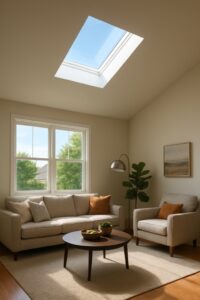
Is letting in more natural light really worth the cost of installing a skylight?
That’s the big question. At first glance, skylights seem like a luxury feature, mostly about looks or lifestyle. But when you start digging into the practical side, there’s a compelling case to be made for their financial benefits too.
Skylights do more than brighten up a room. They can lead to serious long-term savings on energy bills, reduce reliance on artificial lighting, and even increase the overall value of a property. The initial investment might give some people pause, but the numbers behind it often tell a different story.
Let’s look at how skylights can become a smart financial move.
Lower Energy Bills Through Natural Light
Natural light is free. That might sound obvious, but it’s easy to forget just how much of a difference it can make when it replaces the need for artificial lighting throughout the day.
Standard ceiling lights and lamps consume energy. Every time you flip a switch during daylight hours, that’s electricity being used when it doesn’t need to be. By adding skylights to key rooms, especially ones that are often dark or heavily used, you reduce how often you rely on bulbs.
This is especially noticeable in kitchens and bathrooms with limited window space, hallways or stairwells that typically require lighting even in daylight, and living areas that get used most during the daytime.
More natural light equals less demand on your lighting system. That results in lower electricity costs month after month, particularly if you’re lighting large spaces or using high-efficiency bulbs in several rooms.
Reduced Heating Costs in Colder Months
Another less talked-about benefit is passive solar heating. Skylights, when placed correctly, allow sunlight to naturally warm up a space. This is especially effective during colder months when sun exposure can help reduce the need to crank up the heating system during daylight hours.
Here’s how it works:
- The sun enters through the skylight, warming up surfaces inside your home
- That heat is retained for longer in well-insulated spaces
- You end up using less central heating during the day
That doesn’t mean skylights are a replacement for a heating system, but they can certainly take the edge off. Over time, even a modest drop in heating usage can translate into noticeable savings.
Long-Term Value: Adding Appeal to Your Property
When it comes to property improvements, not every upgrade delivers a return. But skylights often stand out to buyers.
Bright, naturally lit homes tend to feel more open and inviting. That emotional connection makes a big difference during viewings and appraisals. A home that feels warm and well-lit will often be perceived as more desirable, even if the actual square footage hasn’t changed.
This can lead to:
- Increased resale value – Natural light is a known factor in property pricing
- Faster selling times – Well-lit spaces often stand out in listings
- Higher rental appeal – Tenants are likely to choose bright, energy-efficient properties
While you can’t always predict market conditions, features like skylights that add both form and function tend to hold long-term value well.
Less Reliance on Artificial Cooling
It’s true that skylights let in sunlight, which might make some worry about overheating in summer. But properly installed, well-ventilated skylights can actually reduce the need for mechanical cooling.
How? Through what’s called passive ventilation. Skylights that can open or tilt allow hot air to escape upwards. This is a natural heat release system that works with the way hot air rises. Instead of depending entirely on fans or air conditioning, your home can self-regulate better.
Of course, this only works when the skylights are installed with proper positioning, insulation, and shading in mind. But when done right, it can lead to gentler summer temperatures indoors without running the air conditioner as often.
What Affects the Financial Return?
Not all skylights deliver the same savings. Several factors influence how much of a return you can expect, including:
- Orientation – South-facing skylights get more sun, while north-facing ones provide softer, more consistent light
- Type of glazing – Double glazing and low-emissivity coatings help control heat loss or gain
- Size and number – Larger skylights let in more light, but you also want to balance with insulation needs
- Installation quality – A poorly fitted skylight can cause leaks or drafts, wiping out any energy savings
- Roof pitch and material – These affect how much sunlight enters and how heat is managed
Spending a little more to get high-quality installation and materials often pays off over the long term. If the goal is financial benefit, cutting corners rarely works.
Skylights That Pay Their Way
Skylights are not just a design choice. When planned and installed thoughtfully, they become a functional upgrade that delivers tangible savings.
They cut energy bills, make heating and cooling more efficient, and add real value to a property. Whether you plan to stay in your home for years or are thinking ahead to resale, the monetary benefits are hard to ignore.
If a brighter space and lower bills sound good, skylights might just be one of the smartest improvements you can make to your home.




Leave a Reply